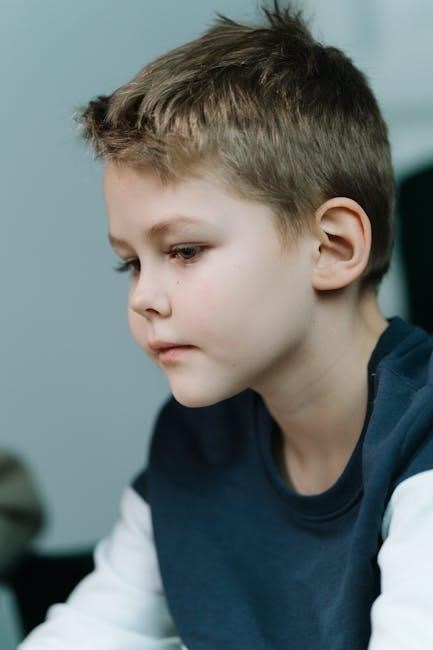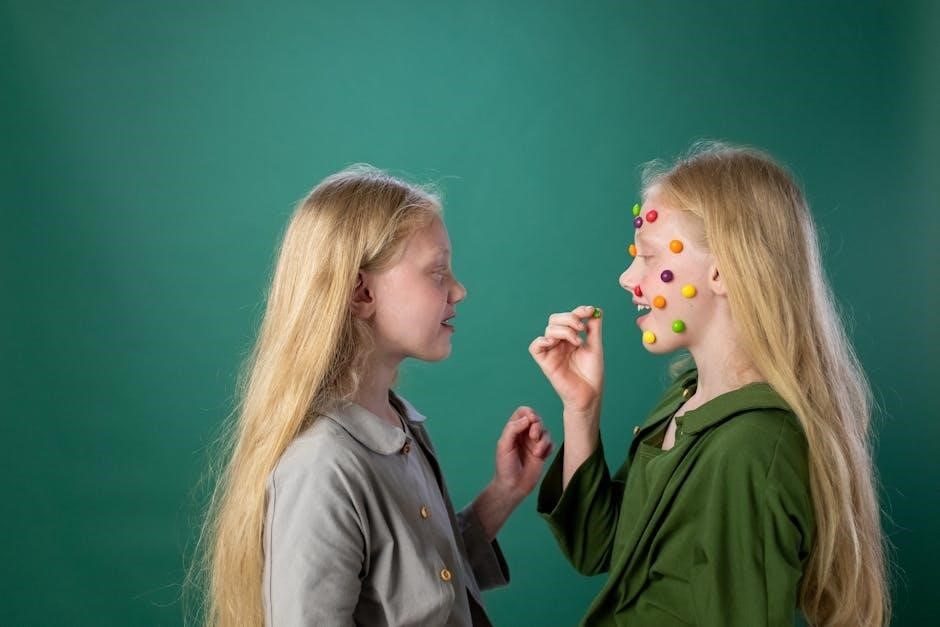The Child Sensory Profile 2 (CSP-2) is a standardized caregiver questionnaire assessing sensory processing patterns in children aged 3 to 11 years, providing a detailed score summary.
Overview of the CSP-2
The Child Sensory Profile 2 (CSP-2) is a caregiver questionnaire designed to assess sensory processing patterns in children aged 3 to 11 years. It provides a comprehensive score summary, offering insights into how children process sensory information. The tool is available in multiple languages, including Persian, ensuring broader accessibility. Parents or teachers with regular contact complete the questionnaire, making it a valuable resource for understanding sensory preferences and challenges in diverse settings.
Importance of Sensory Assessment in Children
Sensory assessment in children is crucial for identifying processing patterns and informing supportive strategies. The Child Sensory Profile 2 (CSP-2) plays a key role by providing standardized insights into how children process sensory information. Early identification of sensory challenges enables timely interventions, promoting better developmental outcomes. This tool is essential for professionals and caregivers aiming to support children’s sensory needs effectively.
Structure of the Child Sensory Profile 2
The Child Sensory Profile 2 (CSP-2) is a caregiver questionnaire for children aged 3–11 years, comprising sections and subscales that assess sensory processing patterns and preferences.
Sections and Subscales of the CSP-2
The Child Sensory Profile 2 (CSP-2) includes sections assessing Auditory, Visual, Vestibular, Proprioceptive, and Touch Processing. Each section evaluates how a child responds to sensory inputs. Additional sections focus on Behavioral and Emotional Responses, providing a comprehensive understanding of sensory preferences and challenges. The questionnaire is completed by caregivers or teachers, offering insights into the child’s sensory processing patterns across various environments and situations.
Key Components of the Questionnaire
The Child Sensory Profile 2 (CSP-2) questionnaire includes 75 items assessing sensory processing across various domains. It uses a 5-point Likert scale to evaluate responses to sensory inputs. The questionnaire is designed for caregivers or teachers familiar with the child’s behavior. It provides a score summary highlighting sensory preferences and challenges, aiding in identifying support strategies tailored to the child’s needs.

Administration and Completion Guidelines
The CSP-2 is completed by caregivers or teachers familiar with the child’s behavior. It is designed for children aged 3 to 11 years, ensuring accurate sensory assessment.
Who Can Complete the CSP-2?
The CSP-2 is designed to be completed by caregivers or teachers who have regular contact with the child, ensuring accurate insights into their sensory processing patterns. It is intended for children aged 3 to 11 years, and the respondents must be familiar with the child’s daily behavior to provide reliable and valid responses. This ensures the assessment reflects the child’s typical sensory experiences and preferences.
Settings for Effective Administration
The CSP-2 is typically completed in familiar settings like homes, schools, or clinics, ensuring the child’s natural behavior is reflected. A quiet, distraction-free environment is recommended to facilitate accurate responses. Caregivers or teachers with regular interaction with the child are ideal respondents, as they can provide insights into the child’s sensory processing patterns in various daily situations.
Scoring and Interpretation of Results
The CSP-2 provides a detailed score summary, highlighting a child’s sensory processing patterns, preferences, and challenges, enabling professionals to identify strengths and areas needing support or intervention.
Scoring Methods and Scales
The CSP-2 uses a standardized scoring system, converting raw scores into scaled scores ranging from 1 to 4. These scores reflect the frequency of sensory behaviors, with higher scores indicating greater sensory-seeking or -avoiding tendencies. The questionnaire includes items assessing auditory, visual, tactile, and other sensory processing domains. Scores are interpreted relative to normative data, providing insights into a child’s sensory preferences and challenges, and guiding targeted interventions or accommodations.
Interpreting the Score Summary
The CSP-2 score summary categorizes a child’s sensory processing patterns into quadrants, such as sensory seeking or avoiding. Raw scores are converted to scaled scores, ranging from 1 to 4, with higher scores indicating more pronounced sensory behaviors. The report highlights strengths and challenges, providing insights into how a child processes sensory information. This data helps identify specific sensory preferences and difficulties, guiding tailored interventions and accommodations to support the child’s needs effectively.

Understanding Sensory Processing Patterns
The CSP-2 helps identify how children process sensory information, categorizing patterns into quadrants like seeking or avoiding. This understanding aids in recognizing strengths and challenges, guiding interventions.
Types of Sensory Processing Patterns
The CSP-2 identifies four main sensory processing patterns: low registration, sensory seeking, sensory sensitivity, and avoiding. These patterns describe how children respond to sensory stimuli, such as auditory, visual, tactile, and vestibular inputs. Understanding these types helps caregivers and professionals recognize a child’s unique sensory preferences and challenges, enabling tailored interventions to support their developmental needs and improve daily functioning.
Identifying Sensory Preferences and Challenges
The CSP-2 helps identify a child’s sensory preferences and challenges by evaluating responses to various sensory experiences, such as auditory, tactile, and visual stimuli. It highlights patterns like sensory seeking or avoidance behaviors, providing insights into how a child processes sensory information. This tool enables caregivers and professionals to develop targeted strategies to support the child’s sensory needs, fostering a more adaptive and balanced sensory environment.

Applications of the CSP-2
The CSP-2 is widely used in clinical and educational settings to assess sensory processing patterns, helping occupational therapists and educators develop strategies for children with sensory challenges.
Clinical Applications in Sensory Assessment
The CSP-2 is a valuable tool for occupational therapists and clinicians to identify sensory processing patterns, develop targeted strategies, and monitor progress in children with sensory challenges. It aids in early intervention, providing insights into how children process sensory information across various environments. By assessing auditory, visual, tactile, and other sensory responses, the CSP-2 helps clinicians design personalized care plans to support sensory integration and improve daily functioning.
Educational and Therapeutic Uses
The CSP-2 is widely used in educational and therapeutic settings to support children with sensory processing challenges. Educators and therapists utilize the questionnaire to identify sensory patterns, develop tailored strategies, and monitor progress. It helps create sensory-friendly environments, inform individualized education plans, and guide therapeutic interventions. The tool also aids in collaboration between parents, teachers, and professionals to ensure consistent support for the child’s sensory needs across all settings.
Validity and Reliability of the CSP-2
The CSP-2 is a reliable tool for assessing sensory processing, validated through confirmatory factor analysis and internal consistency. It effectively measures sensory patterns across diverse populations.
Research on the Tool’s Validity
Research confirms the CSP-2 as a valid tool for assessing sensory processing in children. Studies, including confirmatory factor analysis, demonstrate strong convergent validity. The Persian version, for instance, has shown reliability through internal consistency, ensuring accurate measurements across diverse populations. These findings highlight the tool’s effectiveness in capturing sensory patterns, making it a trusted resource for professionals in sensory assessment and intervention.
Reliability Across Different Populations
The CSP-2 has demonstrated strong reliability across diverse populations, ensuring consistent results. Studies, such as the Persian version, highlight internal consistency, making it a reliable tool for cross-cultural assessments. This reliability is crucial for professionals assessing sensory processing in children from varied backgrounds, ensuring accurate and trustworthy outcomes in clinical and educational settings.
Cultural and Linguistic Adaptations
The CSP-2 is available in multiple languages, including Persian, ensuring accessibility for diverse populations. Cultural sensitivity is maintained to accurately assess sensory processing across different linguistic and cultural backgrounds.
Availability in Different Languages

The Child Sensory Profile 2 is available in multiple languages, including Persian, ensuring accessibility for diverse populations. Its cultural sensitivity and linguistic adaptations make it a reliable tool for assessing sensory processing across different backgrounds. The Persian version has demonstrated validity and reliability, confirming its effectiveness in cross-cultural settings. This adaptability ensures accurate sensory assessments for children from various linguistic and cultural environments, promoting inclusive sensory evaluation practices globally.
Cultural Sensitivity in Assessment
The Child Sensory Profile 2 demonstrates cultural sensitivity through its adaptation into multiple languages, such as Persian, ensuring its validity across diverse populations. The tool’s design accommodates varying cultural norms and practices, making it suitable for global use. This sensitivity ensures that sensory assessments are fair and accurate, regardless of a child’s cultural background, fostering inclusive and effective sensory evaluation practices worldwide.

Case Studies and Practical Examples
A case study involving Anna, a child with sensory processing challenges, used the Child Sensory Profile 2 to identify patterns and tailor strategies, improving her sensory integration abilities effectively.
Real-World Applications of the CSP-2
The Child Sensory Profile 2 is widely used in clinical and educational settings to assess sensory processing patterns in children. Caregivers and teachers complete the questionnaire, providing insights into how children process sensory information. The tool helps identify challenges and strengths, guiding tailored interventions. For instance, in a case study, the CSP-2 was used to evaluate Anna’s sensory behaviors, enabling targeted strategies to support her sensory integration. This practical application highlights its effectiveness in real-world scenarios, aiding professionals and families alike.
Success Stories in Sensory Assessment
The Child Sensory Profile 2 has proven effective in identifying sensory processing patterns, enabling targeted interventions. For example, in a case study, the CSP-2 helped assess Anna’s sensory behaviors, providing insights that guided her care team to develop strategies for sensory integration. Such success stories highlight the tool’s practical benefits in improving children’s sensory experiences and overall well-being, demonstrating its value in real-world applications.
Limitations and Considerations
The Child Sensory Profile 2 relies on caregiver or teacher reports, which may introduce bias. Cultural and linguistic adaptations are essential for accurate assessments across diverse populations.
Potential Limitations of the CSP-2
The Child Sensory Profile 2 relies on caregiver or teacher reports, which may introduce bias. Cultural and linguistic adaptations are essential for accurate assessments across diverse populations. Additionally, the tool’s effectiveness in identifying sensory processing patterns may vary depending on the respondent’s understanding and familiarity with the child’s behaviors. Trained professionals are often required to interpret results accurately, limiting accessibility for some users.
Factors Influencing Accuracy

Accuracy of the Child Sensory Profile 2 depends on the respondent’s familiarity with the child and their ability to observe behaviors consistently. Cultural and linguistic background may affect interpretation, emphasizing the need for adaptations. The child’s age and developmental stage also play a role, as sensory processing patterns evolve over time. Ensuring respondents understand the questionnaire and administer it in appropriate settings maximizes reliability and validity.

Resources and Support
The Child Sensory Profile 2 PDF is accessible online, offering detailed guides and manuals for effective administration. Additional resources include summary reports and support materials for professionals.
Accessing the CSP-2 PDF
The Child Sensory Profile 2 PDF is readily available for download online. It includes a caregiver questionnaire for children aged 3 to 11 years, along with a score summary. The PDF can be accessed through official sources or academic platforms. Ensure authenticity by downloading from verified websites. The questionnaire is designed to assess sensory processing patterns, providing valuable insights for professionals and caregivers. It is also available in multiple languages, such as Persian, for broader accessibility.
Guides and Manuals for Effective Use
Comprehensive guides and manuals are available to support effective use of the Child Sensory Profile 2. These resources include detailed instructions for completing the questionnaire, interpreting scores, and understanding sensory processing patterns. Professionals and caregivers can access user guides, scoring manuals, and interpretation tips to ensure accurate assessments. Additional materials provide insights into administering the CSP-2 and applying results for therapeutic and educational planning, enhancing its practical application.

Future Directions in Sensory Assessment
Future advancements in sensory assessment may include digital integration of the CSP-2, enhanced cultural adaptations, and expanded research into sensory processing patterns across diverse populations globally.
Advancements in Sensory Profile Tools
Advancements in sensory profile tools, like the CSP-2, focus on digital integration, enhancing accessibility and ease of use. Future updates may include AI-driven analysis for faster results and expanded age ranges. Researchers aim to refine subscales for better accuracy and develop culturally sensitive versions, ensuring global applicability. These innovations will help professionals assess sensory processing more effectively, supporting tailored interventions for children worldwide.
Emerging Trends in Sensory Research
Emerging trends in sensory research emphasize the integration of neuroscientific findings to enhance assessment tools like the CSP-2. There is a growing focus on developing culturally adapted versions, such as the validated Persian CSP-2, to ensure inclusivity. Additionally, researchers are exploring the use of digital platforms for data collection and AI-driven predictive analytics to improve accuracy. These advancements aim to provide deeper insights into sensory processing and support early intervention strategies for children.

Conclusion
The CSP-2 is a valuable tool for understanding children’s sensory processing, offering insights that guide therapeutic and educational strategies, ensuring comprehensive support for their development.
Summary of Key Points
The CSP-2 is a validated caregiver questionnaire for children aged 3–11, assessing sensory processing patterns. It provides a detailed score summary, identifying preferences and challenges. Available in multiple languages, including Persian, it ensures cultural sensitivity. The tool is reliable and widely used in clinical and educational settings to guide therapeutic strategies and support children’s sensory development effectively.
Final Thoughts on the CSP-2
The CSP-2 is a valuable tool for understanding children’s sensory processing patterns, offering insights into their preferences and challenges. Its validation across cultures and languages ensures widespread applicability. By guiding interventions and therapies, it supports children’s developmental needs. Accessible as a PDF, the CSP-2 remains a cornerstone in sensory assessment, aiding professionals and caregivers alike in fostering inclusive and supportive environments for children.
References and Further Reading
Key resources include the Child Sensory Profile 2 PDF and SP2 Summary Report, offering detailed insights and validation of the tool’s effectiveness in sensory assessment.
Academic Sources and Research Papers
Research highlights the validity and reliability of the Child Sensory Profile 2, with studies like the 2025 Persian version validation and the 2014 summary report by Winnie Dunn, PhD. These papers confirm the tool’s effectiveness in assessing sensory processing patterns, supported by confirmatory factor analysis and internal consistency. Additional studies, such as the toddler sensory profile, provide insights into sensory behaviors, making these resources essential for professionals and researchers in the field.
Recommended Reading for Professionals
Professionals are encouraged to explore the Child Sensory Profile 2 manual, research papers on its validity, and practical guides for sensory assessment. Key resources include the 2025 Persian version validation study, the 2014 summary report by Winnie Dunn, PhD, and the toddler sensory profile. These materials provide in-depth insights into sensory processing patterns, clinical applications, and educational strategies, making them essential for effective use of the CSP-2 in therapeutic and educational settings.
Frequently Asked Questions (FAQs)
Who can complete the CSP-2? Caregivers or teachers with regular contact with the child can complete the questionnaire. Where can I find the CSP-2 PDF? It is available for download online, including versions for different languages and age groups.
Common Queries About the CSP-2
Common questions about the Child Sensory Profile 2 (CSP-2) include its purpose, who can complete it, and where to access the PDF. Many inquire about its validity, reliability, and cultural adaptations. Others ask about the scoring process and how to interpret results. Additionally, users often seek guidance on administration settings and the best practices for completing the questionnaire effectively. These queries highlight the tool’s practical applications and user concerns.
Addressing Concerns and Misconceptions
Some concerns about the Child Sensory Profile 2 (CSP-2) include its accessibility and ease of use. Misconceptions arise about its requirement for professional training, but it is designed for caregivers and teachers. The tool is validated through research, ensuring reliability across diverse populations. Cultural adaptations and translations address accessibility concerns. Guides and manuals are available to support effective use, making it a practical and user-friendly assessment tool for sensory processing patterns in children.
Downloading and Using the CSP-2 PDF
The CSP-2 PDF is accessible online, enabling caregivers and educators to download and complete the questionnaire. It includes a detailed score summary for understanding sensory processing patterns, ensuring reliable and effective assessment based on research.
Steps to Access the PDF Version
- Visit the official website or authorized platforms hosting the CSP-2.
- Search for “Child Sensory Profile 2 PDF” to locate the document.
- Download the file, ensuring it includes the caregiver questionnaire and score summary.
- Create an account if required for access.
- Save the PDF for printing or digital completion.
- Verify the file’s integrity to ensure it’s complete and accurate.
- Consult professionals for guidance on administration and interpretation.
Best Practices for Completing the Questionnaire
- Ensure the caregiver or teacher has regular, direct contact with the child.
- Complete the questionnaire in a quiet, distraction-free environment.
- Answer questions honestly, based on the child’s typical behavior.
- Avoid guessing; leave blank if unsure about a response.
- Review all items carefully to ensure accuracy.
- Seek clarification from professionals if needed.
- Submit the completed form securely to maintain confidentiality.
